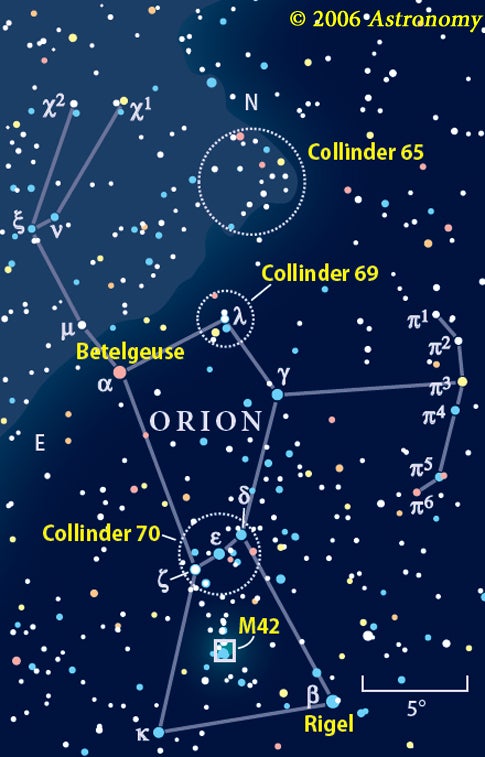An easy catch
This week’s naked-eye object is an asterism all beginning observers should be familiar with: Orion’s Belt. As its name implies, these three stars mark the belt of Orion the Hunter, the winter sky’s brightest and best-known constellation. On Christmas night, the belt rises in the east around 5 p.m. local time. Give it a couple hours to rise high enough for you to easily locate it.
Once you find the belt, use it as a pointer. Draw a line up from the belt until you come to a V-shaped group of stars called the Hyades. This V, which contains the bright star Aldebaran, marks the head of Taurus the Bull. Continue the line upward, and you’ll find the Pleiades star cluster, also known as M45.
Extend a line downward from the belt, and you’ll find the night sky’s brightest star, Sirius (Alpha [α] Canis Majoris), the luminary in the constellation Canis Major the Large Dog.
A twin cluster
This week’s small telescope target is open cluster M35 in Gemini the Twins. Actually, under a dark sky, most people can spot M35 as a fuzzy patch without optical aid. But it looks best through a telescope.
M35 lies 2.3° northwest of magnitude 3.3 Eta (η) Geminorum. This terrific cluster contains dozens of stars brighter than 10th magnitude. A 6-inch telescope will reveal more than 150 within M35’s central 20′. In this region, look for a string of stars some 10′ long shaped like a saxophone.
Through larger telescopes, look for NGC 2158, a fainter open cluster in the same field of view. Seeing NGC 2158 isn’t difficult, but resolving its stars requires a larger scope and high magnification.
Merry Christmas
I chose this week’s deep-sky object for its seasonal name. The Christmas Tree Cluster, also known as NGC 2264, lies in the faint constellation Monoceros. At magnitude 3.9, this grouping of stars is easily bright enough for you to spot with your naked eyes, albeit as an indistinct fuzzball.
At a magnification of 50x, you’ll see a dozen or so stars to the east and west of the magnitude 4.7 star 15 Monocerotis. This line forms the half-degree-long base of the Christmas tree. Its top points to the south.
Although they form the tree’s top, the southern stars don’t belong to this cluster, which lies approximately 2,500 light-years from Earth.
Through a 12-inch or larger telescope, you’ll see a bright strip of nebulosity some 5′ long. It seems to radiate westward from the brightest star. This gas belongs to the emission nebula Sharpless 2–273, which stretches an additional 2° to the west.
At the top of the Christmas Tree Cluster lies the Cone Nebula, an obscuring cloud of dust visible only through the largest amateur telescopes.
Podcast: Orion’s Belt, open cluster M35, and the Christmas Tree Cluster
Each week, Senior Editor Michael Bakich highlights three targets visible in the night sky. One object you can see without optical aid, one you can see with a small telescope, and one deep-sky object you can see with an 8-inch or larger telescope.
In this episode, he highlights Orion’s Belt, open cluster M35, and the Christmas Tree Cluster and explains how to see these objects your night sky. Listen to podcast.
StarDome
Astronomy.com’s interactive star chart, StarDome, displays an accurate map of your sky. It’ll help you locate this spectacle. Astronomy magazine subscribers have access to a slew of cool functions with StarDome PLUS.
Free weekly newsletter
Receive news, sky-event information, observing tips, and more from Astronomy‘s free weekly e-mail newsletter. Sign up today!
- December 19-26, 2008: The Kids, Pazmino’s Cluster, and the Flaming Star Nebula
- December 12-19, 2008: Hyades star cluster, open cluster M37, and NGC 1275
- December 5-12, 2008: Kemble’s Cascade, open cluster M36, and barred spiral galaxy NGC 925
- November 27-December 5, 2008: Venus and Jupiter, open cluster M38, and spiral galaxy NGC 1365
- November 21-28, 2008: Alpha Persei Association, open cluster M103, and spiral galaxy IC 342










